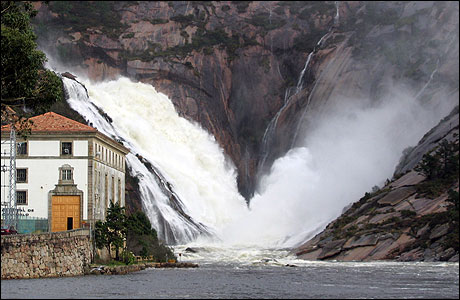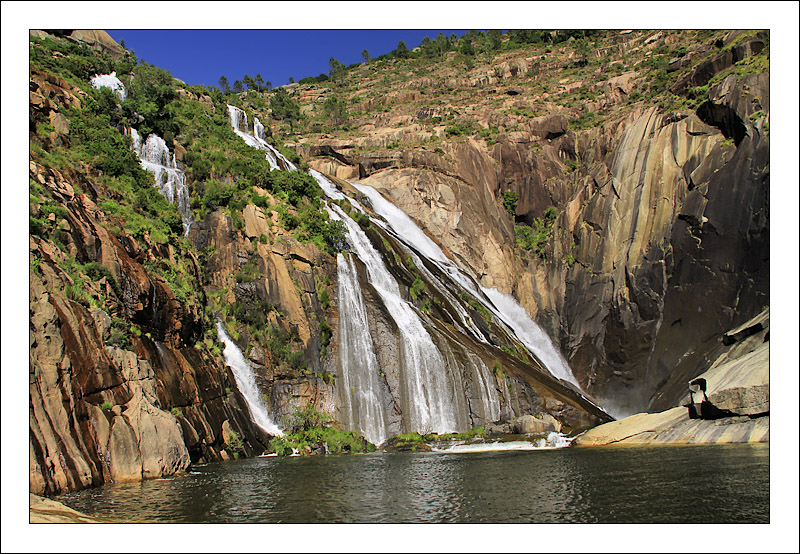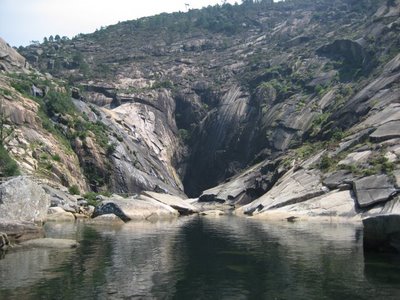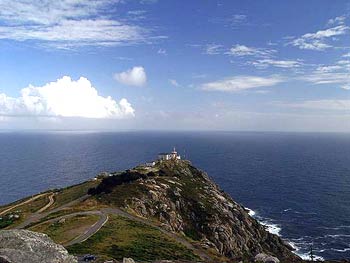
In the municipality of Dumbría, near Cape Finisterre, one can find the river Xallas and the Santa Uxía reservoir, a hydroelectric plant which unfortunately intervened with nature. Its gates are opened every Saturday and Sunday during the summer, creating once again the spectacular waterfall that can be seen in the photo – locally it is called “Cadoiro” - and the waterfalls from a height of 100m into a pit which is approximately 20 feet deep, forming an inlet that empties onto Ézaro beach, one of the most beautiful along the coast. However this is not because of the dam, the waterfall has always existed, the dam just regulates the opening hours, excuse the pun.

Before the dam was built, which by the way has ruined a little the landscape, this waterfall ran free and you might be asking what is so different about this one? Well, it is in fact the only waterfall in Europe that flows directly into the sea, however now it only falls during working hours and in peak season! The waterfall is open and running from 12:00 to 14:00 every Saturday and Sunday from 21 June to 21 September, and sometimes on bank holidays! One has to serve the tourists.

About a mile away is a viewpoint from which you can see the whole estuary of Corcubión. Ézaro, which is the only access to the sea within Dumbria, has three beaches: A Pedra Maior; Forcado, where the locals go and Area Pequeña, which as its name suggests is the smallest of the three.
 Nearby there is the mountain O Pindo, which is an archaeological site where you can go trekking and discover the ruins and areas where ancient Druids carried out their rituals. From its summit -A MOA at a height of 641 meters, you can enjoy a great view and see stones with ancient inscriptions. Another place nearby is Carnota, which is famous for being home to the longest Hórreo (granary on stilts) in Galicia, supported by 11 pairs of columns and has been declared a national monument.
Nearby there is the mountain O Pindo, which is an archaeological site where you can go trekking and discover the ruins and areas where ancient Druids carried out their rituals. From its summit -A MOA at a height of 641 meters, you can enjoy a great view and see stones with ancient inscriptions. Another place nearby is Carnota, which is famous for being home to the longest Hórreo (granary on stilts) in Galicia, supported by 11 pairs of columns and has been declared a national monument.
Following the route, one reaches Corcubión, a historic and artistic enclave. This region is full of legends and magical areas, noting especially, Cape Finisterre, which is almost mandatory to visit and contemplate its beautiful sunsets. In the same spot that people centuries ago considered the end of the earth, where the land ended and the sea began. The Phoenicians built an altar at which the Sun was worshipped. Many who came to Santiago on pilgrimage then continued to the lighthouse of Finisterre to burn the shoes that they had used on their long journey, a tradition that still stands today and is carried out beside the monument next to the lighthouse.
Ver mapa más grande